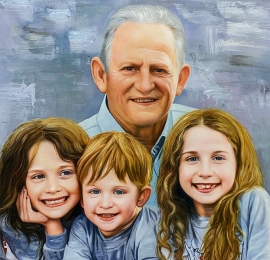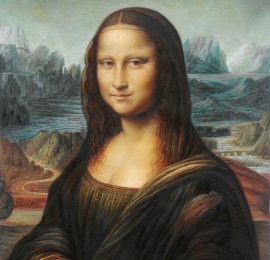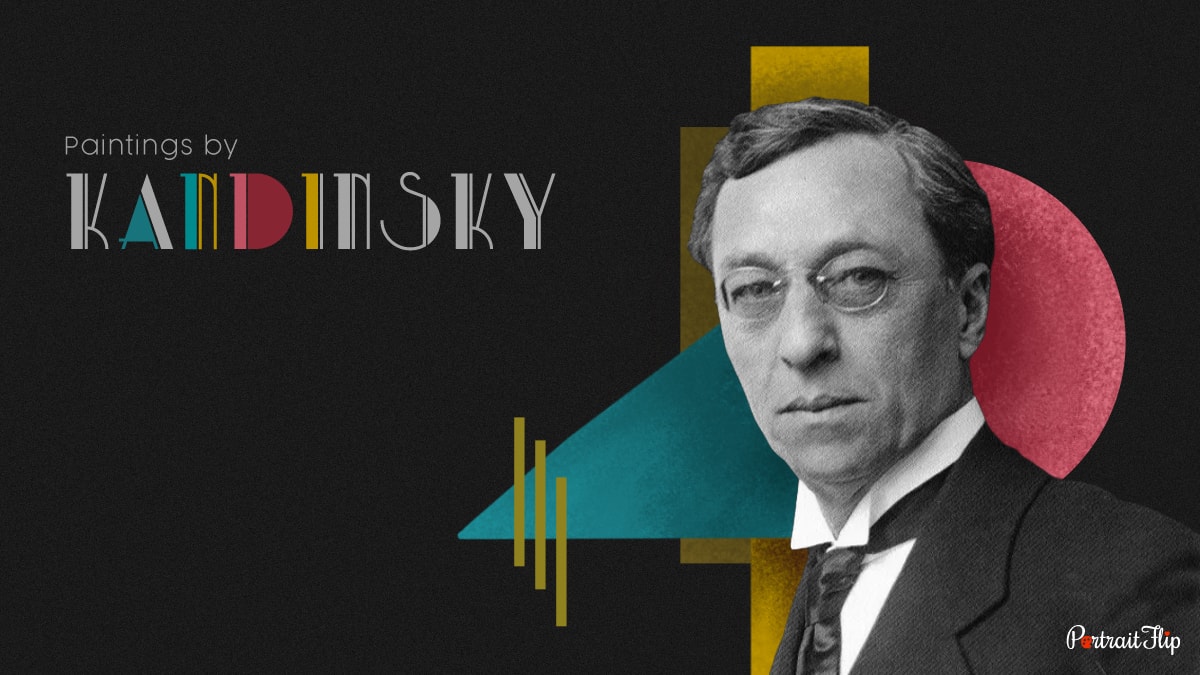A pioneer of abstract art and expressionism, Wassily Kandinsky was born in 1866 in Moscow, Russia. Unlike other artists, Kandinsky started his career as a scholar of Law and Economics at University of Moscow.
After which, he was offered a professorship at University of Dorpat (University of Tartu,Estonia; currently).
An art lover by heart, Kandinsky left his job as a professor in a quest to learn art. He flew to Munich, Germany where he met a few prominent artists of the post-impressionism era.
Kandinsky was an artist by nature. He learnt to play cello and violin at a very young age. Who knew his musical intelligence would intersect with his artistic abilities to replenish the abstract art movement completely.
Kandinsky’s primary inspiration to create perception based artworks was Claude Monet’s paintings, Haystacks series. He was impressed with the use of light and visual angles in order to create perceptual illusions.
Table of contents
- Color Theory:
- Okhtyrka, Autumn
- Sunday (Old Russian)
- Couple On Horseback
- Blue Mountain
- Houses In Munich
- Murnau, Train And Castle
- Landscape With Factory Chimney
- Improvisation 27, Garden Of Love 2
- The Cow
- Study For Improvisation V
- Composition 6
- In The Grey
- Yellow-Red-Blue
- On White II
- Circles In A Circle
- Epilogue:
- Authors Note:
- FAQs
Color Theory:
Being a prominent art theorist, Kandinsky and his theory of color completely changed the scenario of abstract art.
According to Kandinsky, “Every color has a feeling, a sensation and a sound”.
Different colors can evoke different emotions and sounds. For instance; Green is the most placid color, it’s just like the sound produced by middle notes of a violin.
White color symbolizes the pauses between musical notes that break the harmony. Light red represents the ringing sound of Trumpet and Black represents the dead silence of the final pause.
After getting acquainted with the artist and his ideologies, let’s dive deeper into his artworks. Here’s a list of 15 Paintings by Kandinsky that portray his thoughts as an expressionist.
1. Okhtyrka, Autumn
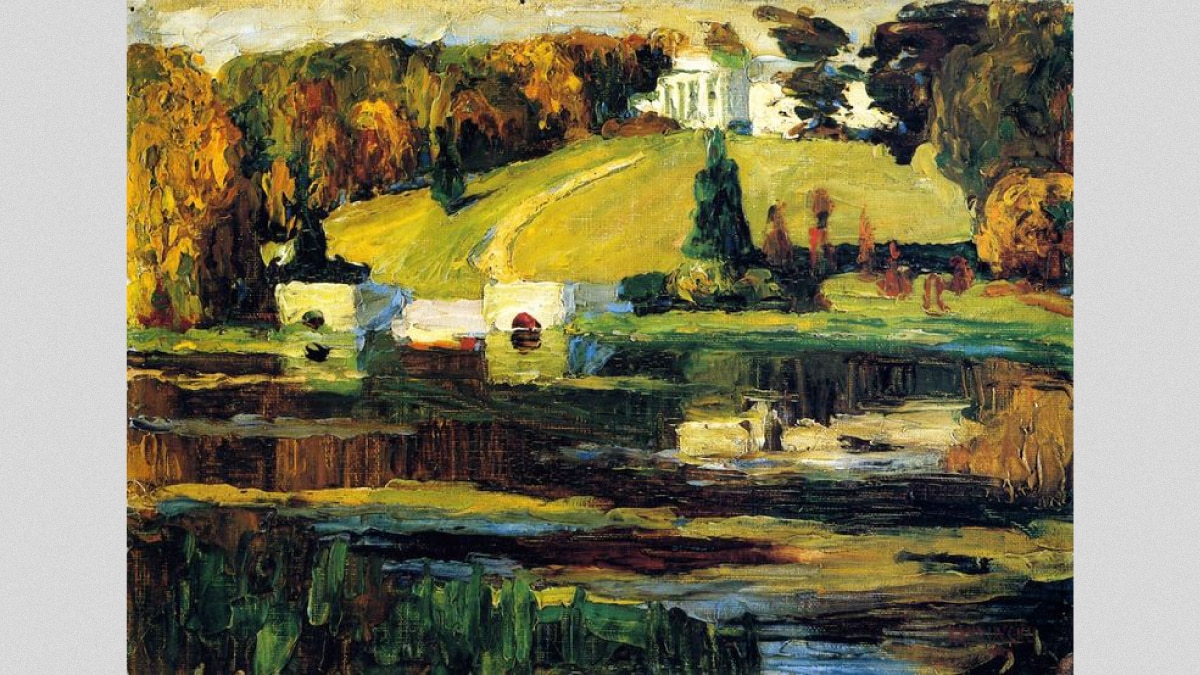
Painted in an oil on canvas medium in 1901, this is one of the few Wassily Kandinsky paintings from the Okhtyrka series.
Russian painter Kandinsky has drafted a meadow scene from Okkhtyrka (Currently located in Ukraine). The color scheme of the painting justifies its abstract nature.
The smudged color imprints signifies placidity of the landscape present in this artwork. This one of the paintings by Kandinsky, through which he has portrayed the expressionism present in nature.
Autumn is the season of transition. The leafs get liberated from the trees and the tree embarks upon a new journey with new leafs.
Kandinsky portrayed the significance of liberation with the slightest form of nuances available in nature. The level of fluidity in this artwork is impeccable.
2. Sunday (Old Russian)
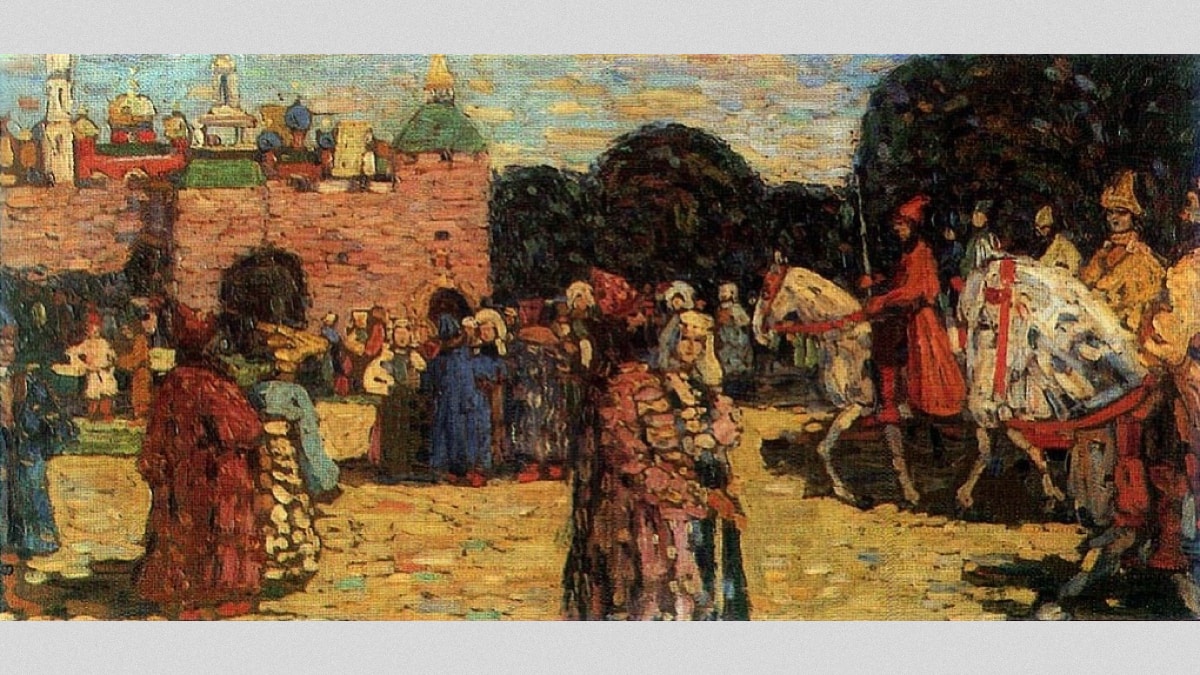
“The artist must train not only his eye but also his soul”. This quote by Kandinsky, speaks for his thirst to master the art of abstraction to express it in a highly evocative manner.
Pulling off dematerialized expression from a highly materialistic scene was something only Kandinsky could do. Sunday (Old Russian) is a prominent example of that.
A period painting displaying a market scene from medieval Russia. The crowd and the chaos shown, usually occurred on a holiday or maybe on a week off, that justifies the title of the painting.
This is one of the oil paintings by Kandinsky. It’s one of those Wassily Kandinsky artworks, which fetched him prominence as an expert on the subject of expressionism.
3. Couple On Horseback
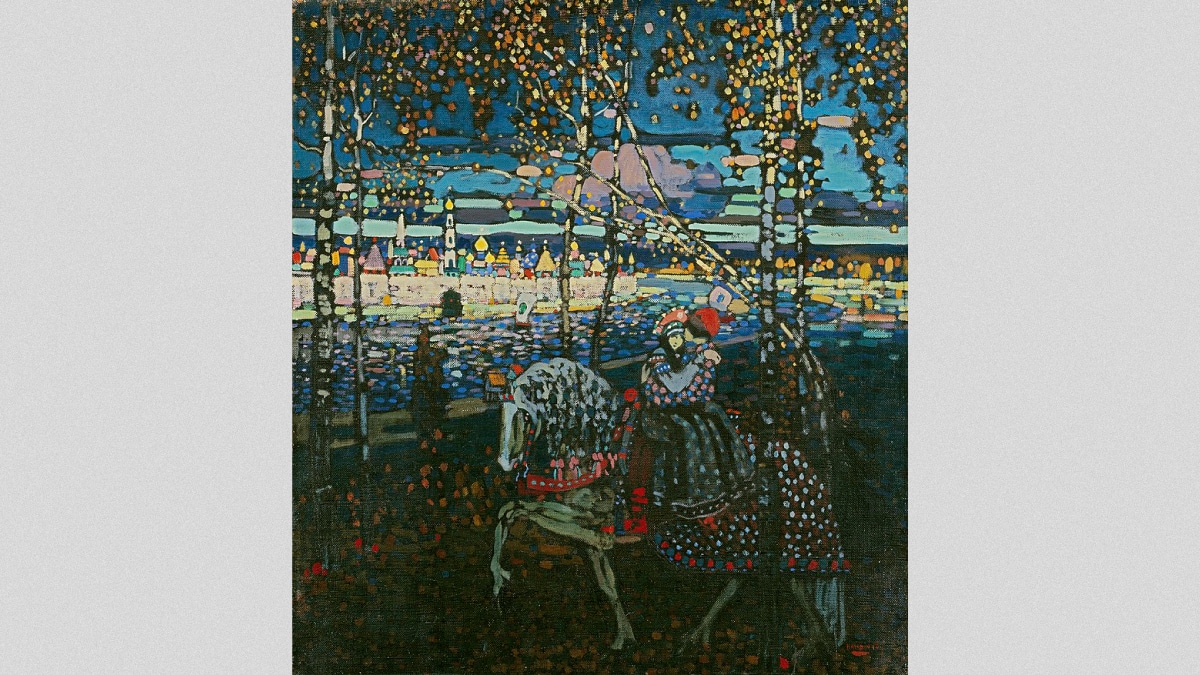
As an artist who could witness the sound of colors, Kandinsky always found inspiration in creating a cosmos of colors through his artworks.
His peculiar choice of color schemes and creative liberty in amalgamating them made this painting an epitome of expressionism.
A couple riding a horse amidst a mesmerizing view of the city in the season of fall. With golden spires and a glittering river in the backdrop along with lustrous leaves showering upon them, the couple is sharing a moment of compassion with one another.
The sound of this painting would have appeared mellow and harmonic to Kandinsky as the color scheme suggests. The spotted outlining of the figures gave it an edged look altogether.
The clothing elements of the couple in this painting appear to be luxurious and classy yet it’s well blended with the central theme of the artwork.
Being one of the most expressive paintings by Kandinsky, it portrays the profoundness of dematerialized love. He has broken boundaries of classical realism in order to express figurative expressionism between the couple.
How about having a Kandinsky Painting hung at your wall? Try a Kandinsky Reproduction painting from PortraitFlip!
Did you know you can get any ordinary photo of your choice transformed into an artistic masterpiece!
Our artists create a marvelous piece of art without hindering the central subject of the photo!
4. Blue Mountain
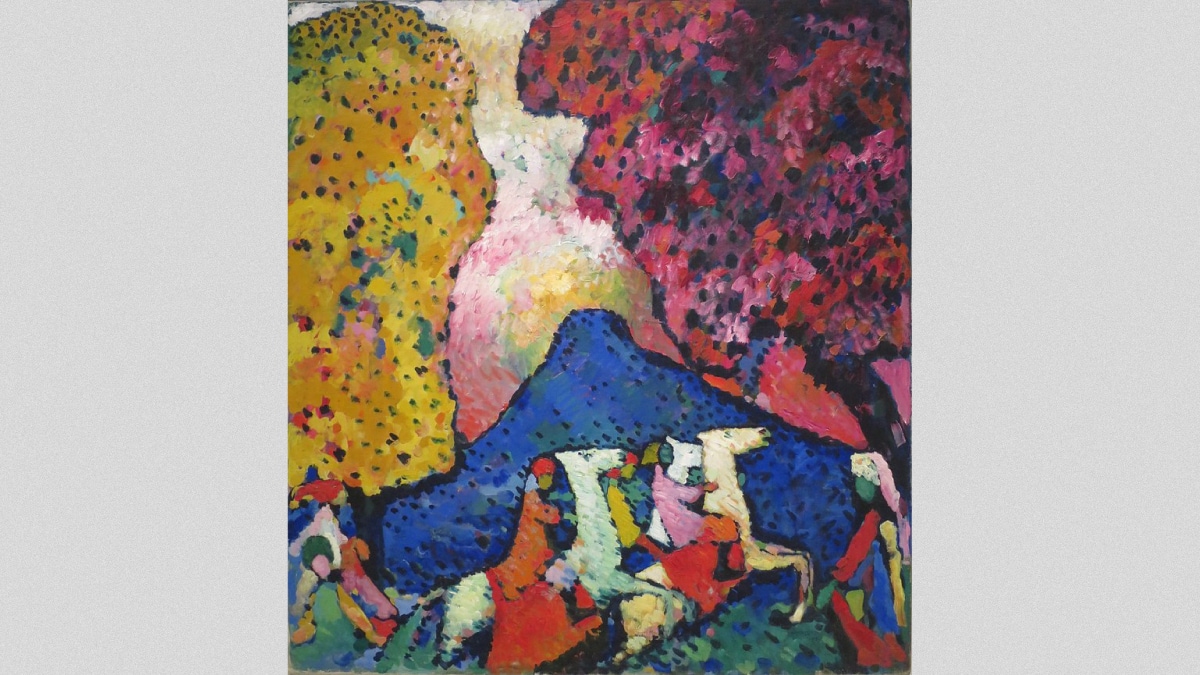
A dreamy landscape with undefined boundaries, non naturalistic color schemes and uneven strokes, It just sounds like a scene from Wassily Kandinsky paintings.
The artistic elements of this painting render the artists motivation to portray his precarious thoughts using references from Fauvism.
There isn’t any central subject of this painting, yet the title sheds some light on the centrally drafted Blue Mountain. This avant-garde artwork has a few elements of Fauvism, such as flat planes and blocks of color.
Kandinsky’s emphasis on expressing emotions through colors in this painting is an institution within.
The red represents sadness and sorrow, The Blue represents serenity and bliss and yellow signifies excitement. The crusaders on the horses represent the speed and intensity of emotional alterations.
This artwork represents the prowess of Wassily Kandinsky paintings in depicting expressionism.
Suggested Read: Paintings by Renoir
5. Houses In Munich
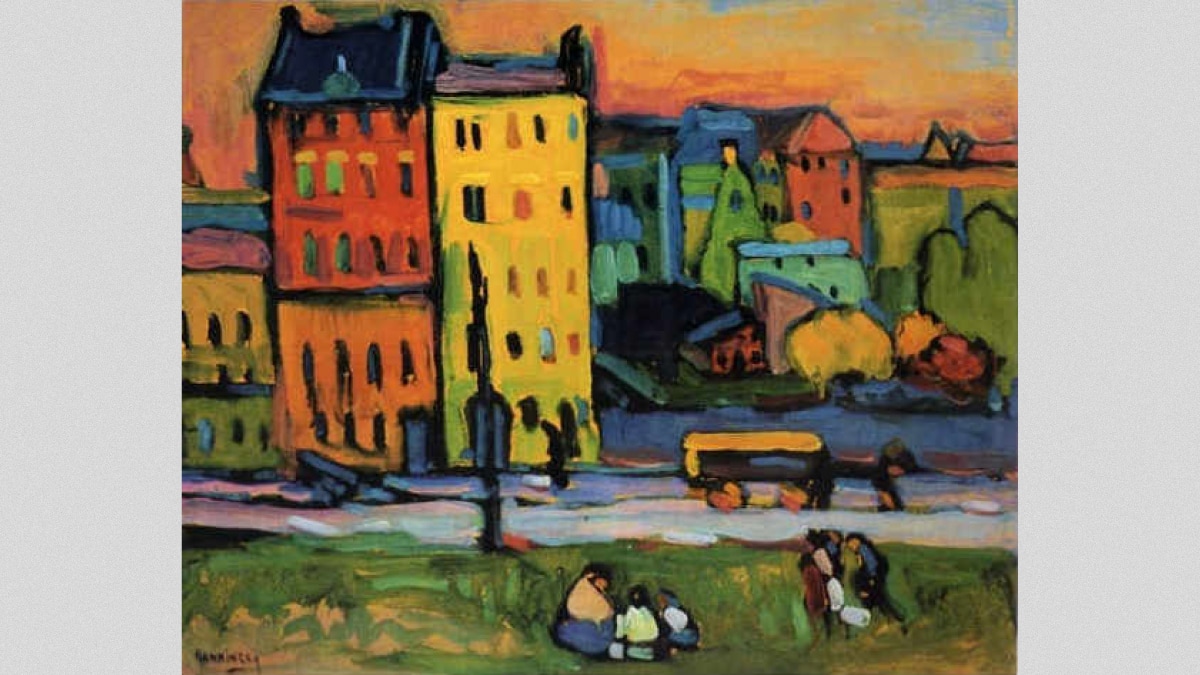
Munich was the place where Kandinsky started his journey as an artist in 1896. He created this masterpiece 14 years later in 1908.
Known for a spiritual and philosophical touch to his artworks, Kandinsky painted a polar opposite of his signature style in “Houses in Munich”.
Although he drafted an urban setting with nearly outlined figures, the uneven strokes and color gradients gave it an abstract look.
The shaky color scheme brings out the element of expressionism in this artwork. It seems that Kandinsky exhibited a desire to grasp the metaphysical world engraved in this physical world.
Being a pinnacle of expressionism, Wassily Kandinsky layered this painting with an ultimate approach of spiritual perspective.
Also Read: Paintings by Johannes Vermeer
6. Murnau, Train And Castle
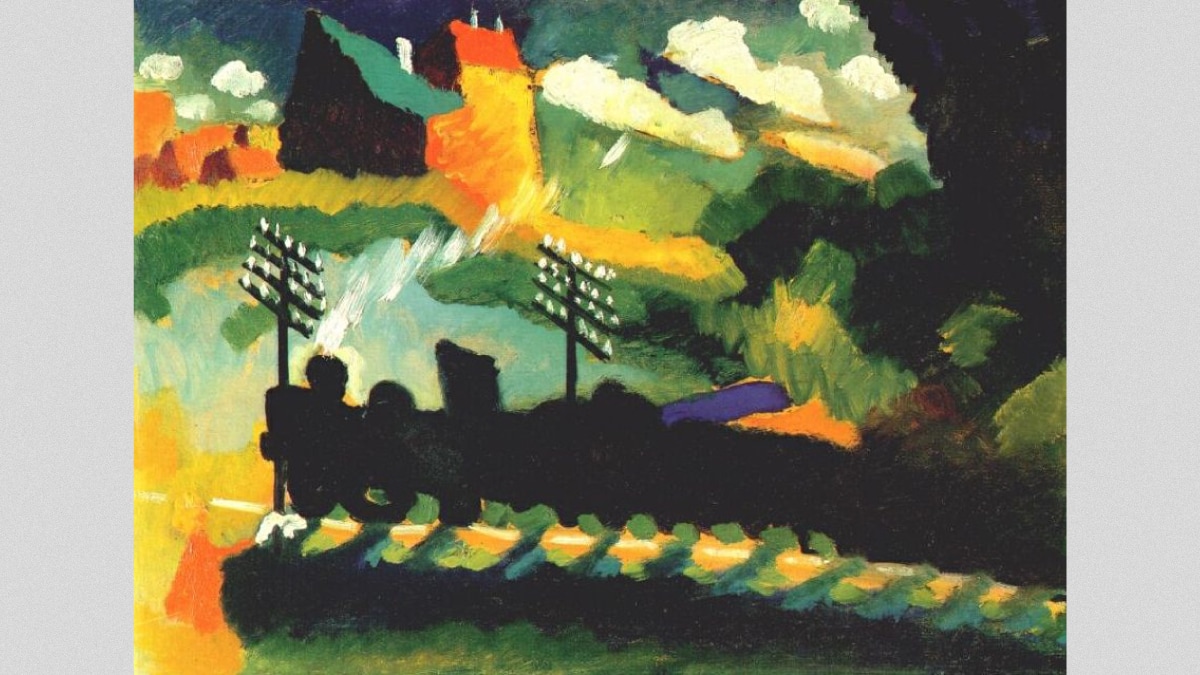
Created in 1909 as an oil painting on canvas, this is a gist of abstract art altogether from paintings by Kandinsky.
Smudged and soft strokes, uneven color palettes and gradient color schemes—all these attributes depict the perfect portrayal of an expressionism artwork.
The dark smudges used to paint the train are used so freely that they resemble liberation at par.
The composition of colors speaks about the auditory intelligence of Wassily Kandinsky. The use of Green for placidity, use of orange for excitement, use of black for silence is immaculately on-point.
Use of a landscape element along with a castle and a train is indeed a very difficult idea to depict expressionism. Yet, Kandinsky pulled it off in a very subtle and smooth way.
7. Landscape With Factory Chimney
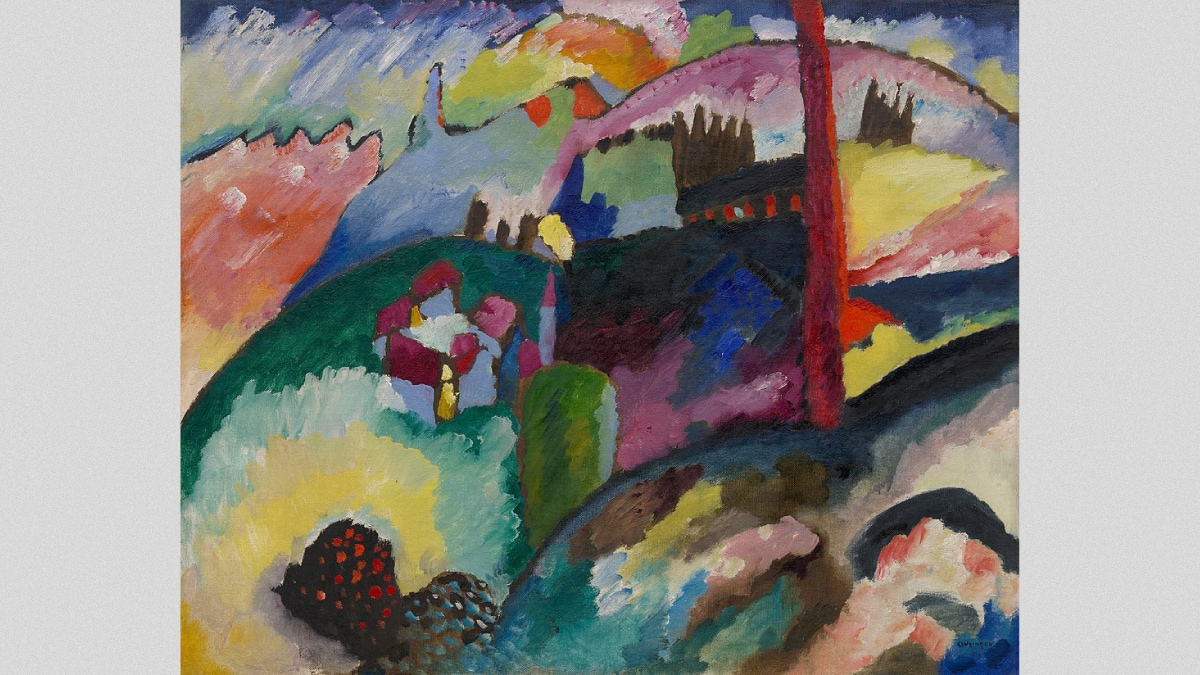
This is one of the few paintings of Wassily Kandinsky with a few rudiments of Fauvism. Any element in this artwork is not kept in the boundation of an outline.
Yet, Kandinsky addressed them with utmost subtlety and they are identifiable to a layman.
The landscape is a mesmerizing blend of several shades of blue, yellow, red and green. The artist used all four colors of completely opposite polarity to portray the natural dynamism of a landscape.
The factory is usually a noisy place, However Kandinsky chose to paint it black which represents dead silence.
The contrary and non naturalistic color scheme of this artwork speaks to the abstract nature present in it. Plus, it portrays the essence of inner necessity of knowing the spiritual secret.
Also read: Color Study: Squares with Concentric Circles (In-depth Guide)
8. Improvisation 27, Garden Of Love 2
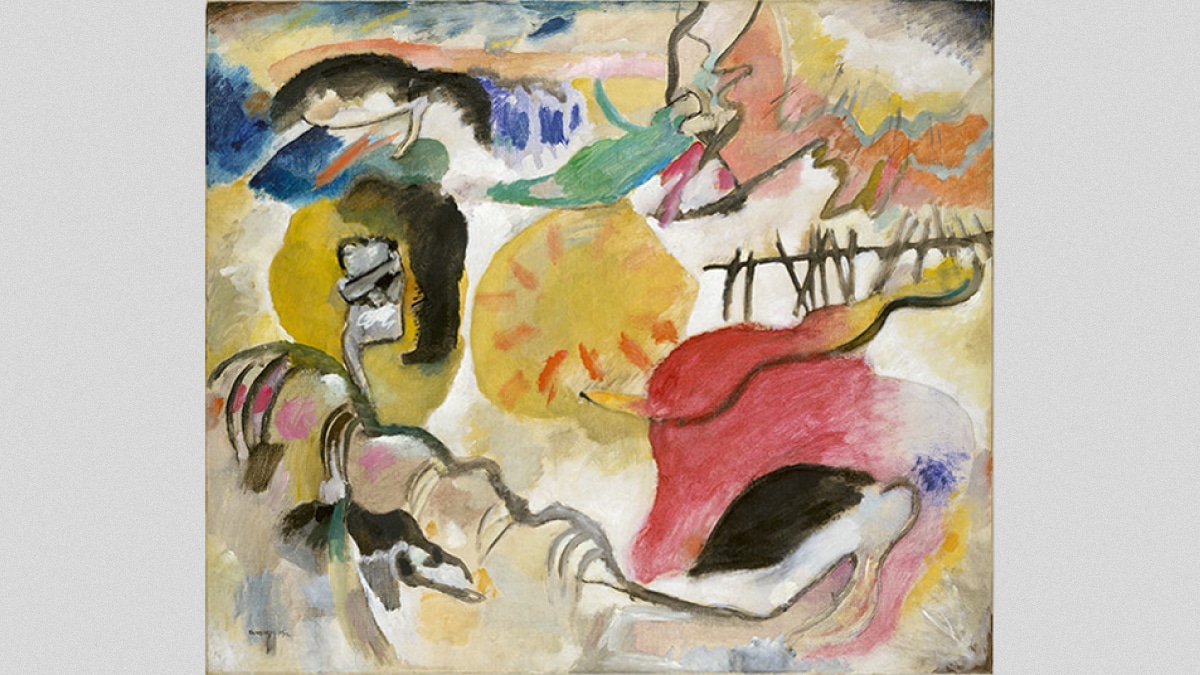
Kandinsky rejected the idea of depicting materialism through his art at the very beginning of his career. He always referred to boundless spiritual expressionism as a form of art.
This Wassily Kandinsky painting portrays evocation of inner emotional and spiritual needs while embracing the abstract desires of the soul.
It’s hard to identify a central subject in such a perfect abstract art. Nevertheless, a biblical couple happens to be the principal element of this painting.
Surrounded by serpentine creatures, this couple seems to be embracing the liberated feeling and emotions with their devotion at par.
Artworks like these leave behind an imprint of the artist’s philosophy for the world to appreciate.
Also Check Out: Paintings By Michelangelo
9. The Cow
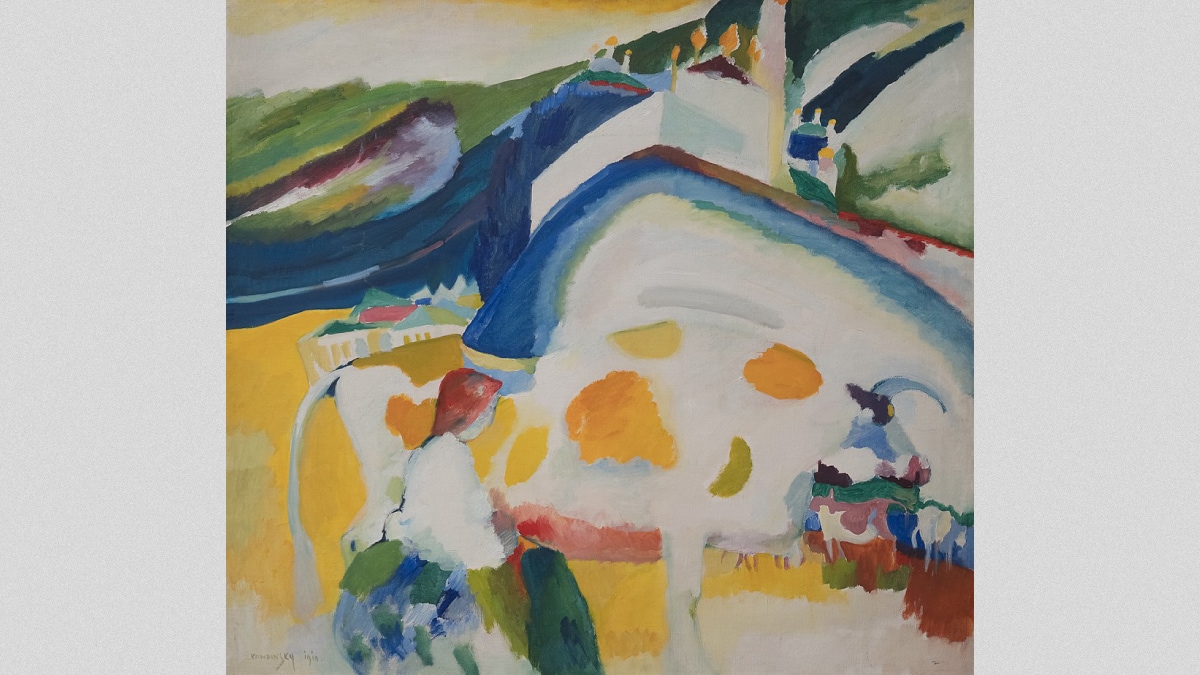
There are numerous paintings from the expressionism movement that involve animals as the central subject to depict abstract art. One of them happens to be “The Cow” by Wassily Kandinsky.
Painted in 1910, The Cow is an oil painting on canvas. The composition of this painting involves shades of yellow, blue and white predominantly.
The cow is the central figure of the painting and reflects Kandinsky’s expertise in creating visual perspective through illusion with his colors.
Kandinsky has painted the rest of the canvas and left a white space in shape to create a cow-like figure with a few yellow and blue strokes. He showcased the true excellence of “Wassily Kandinsky art” through this painting.
The hump of the cow looks like a mountain outline with a few strokes of blue. This Motif depicts the perpetual perspective of non-material things in life.
Kandinsky certainly conveyed his message through this brilliant piece of art.
10. Study For Improvisation V
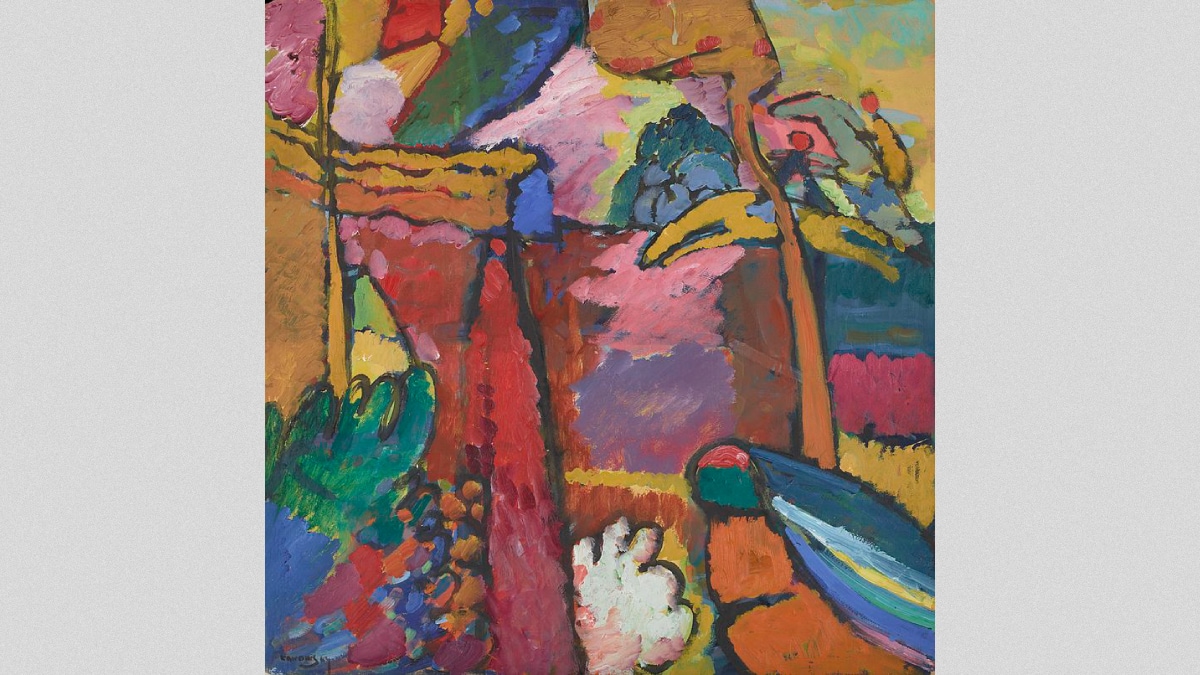
It’s a painting with a motive to inculcate spiritual awakening by honing the inner character upon the real, non-material truth.
This painting is one of the accomplices of Kandinsky to invoke non-material devotion. In the frame, a woman is seen on her knees before a heavenly resolute figure, probably Jesus Christ, in a devotionally merciful state.
The explosive color scheme and bumpy strokes suggest that the scenario is of a biblical apocalypse. The inner-unconscious immediately makes you kneel down and beg for mercy.
The sound of the painting is a beautiful noise depicting the essence of “Apocalyptic Music”.
11. Composition 6
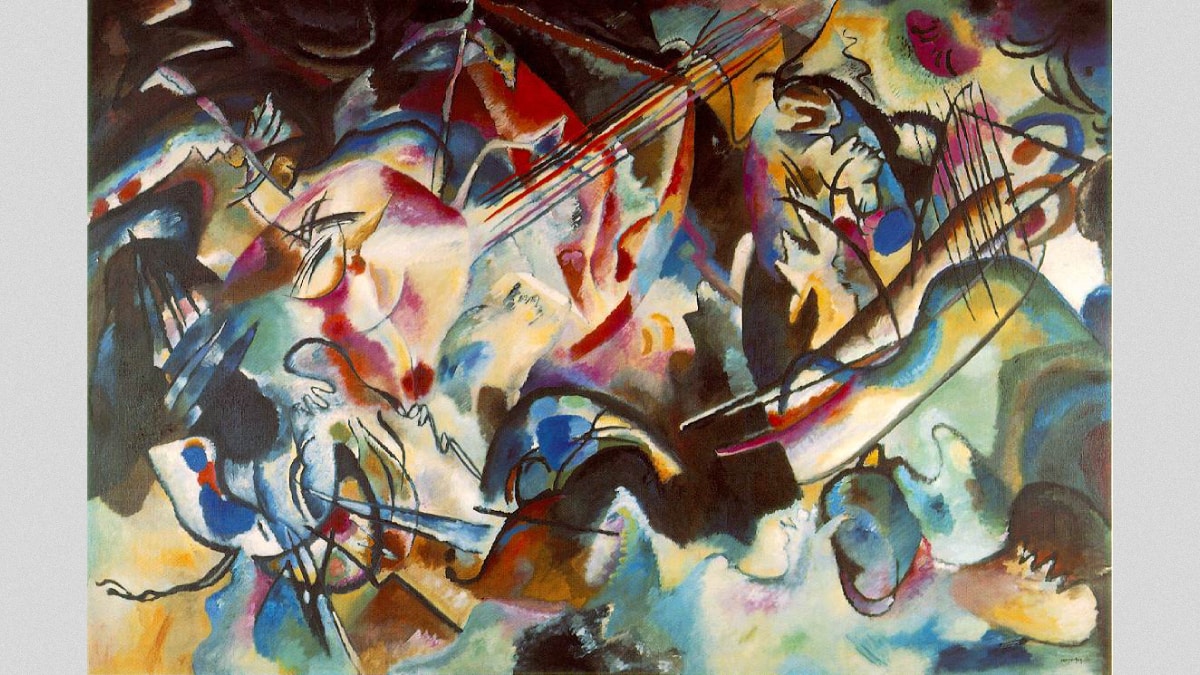
Another biblical masterpiece by Kandinsky, which nearly required 8-9 months to complete. A highly complex and layered painting, Composition 6 by Kandinsky is a portrayal of a highly disastrous flood (Uberflut in German).
The use of variant color schemes with irregularities of outlines depict the fatal and uncertain nature of a flood. Kandisky didn’t even leave a single mark where he hasn’t justified destruction in this painting.
This painting creates a delusion within its layers. It keeps on appearing to be more chaotic with every glance. That’s how a flood is.
Kandinsky was facing a creative blockage initially. However he took help from his assistant Gabriel Munter and came up with this superlative artwork.
Being of the most deep and intense paintings by Kandinsky, this artwork bestows artistic intelligence among the viewers.
Kandinsky has made compositions varying from I to X amongst which some of the most famous editions are Composition VII, VIII and VI.
Suggested Read: Composition 8
12. In The Grey
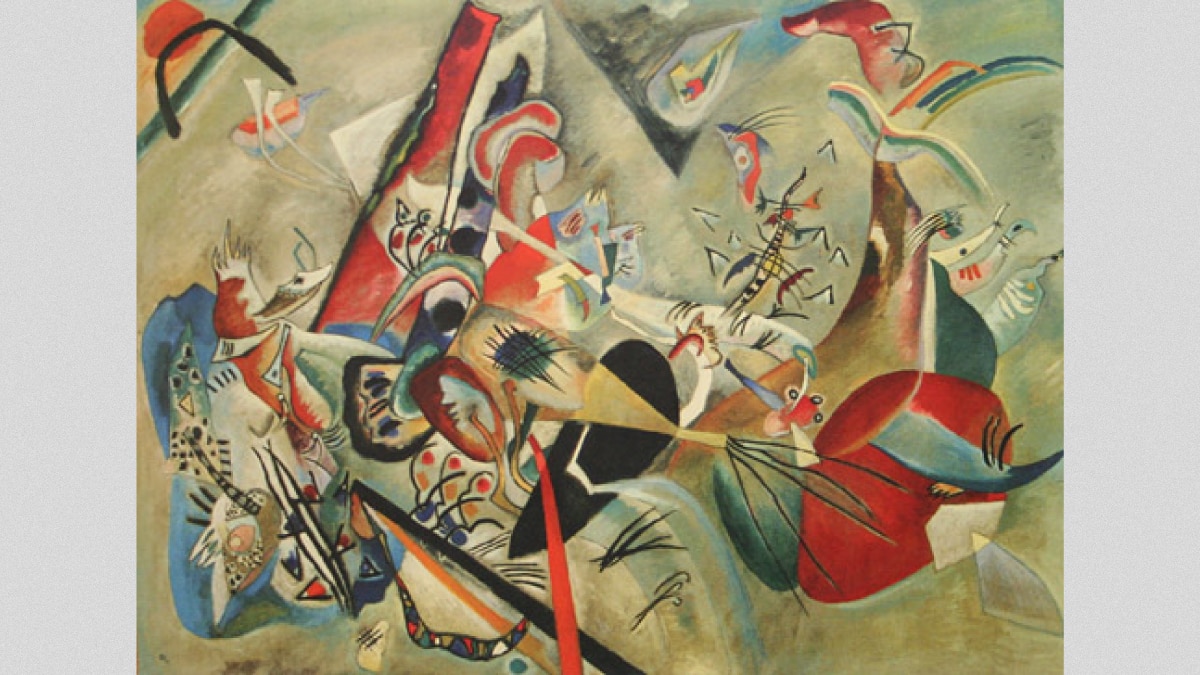
In the Grey or Im Grau, a complex composition consisting of numerous geometric shapes and indefinite figures, which serve a prime example of Kandinsky’s mastery in depicting boundless and timeless expressions.
These shapes with several color schemes floating and dancing in a gray space portray numerous inner emotions roaming around with different intensities in our subconscious.
The muted and vague colors signify emotional voids left behind due to situational needs at several instances.
Wassily Kandinsky has made an attempt to provoke inner emotions to break all the barriers and attain liberation from the material world.
This is one of the most spiritually invoking paintings by Kandinksy.
13. Yellow-Red-Blue
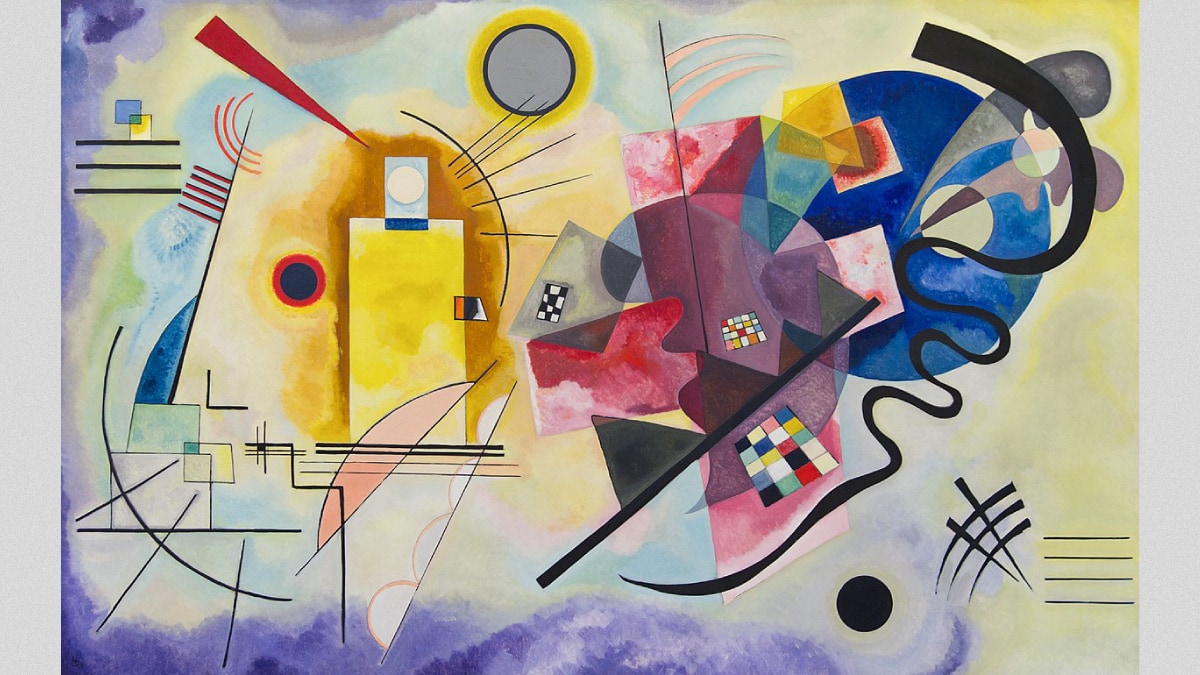
One of Wassily Kandinsky famous paintings to feature definite abstract shapes in order to provoke thoughts of the viewer.
The composite of three foundational colors Yellow-red-blue creates a cloud of inner emotions and allows the person to think beyond societal speculations.
Kandinsky used Motifs to captivate the viewers and present different perspectives for a higher spiritual experience.
The shapes and figures are made with immaculate clarity to depict a subtle sense of spiritual surrealism.
This painting can be divided into different parts with different influences on the viewer mindset. Kandinsky’s geometrical brilliance along with his acoustic mastery of colors hits every right spot in this painting.
Suggested Read: Surrealist Paintings That Inspire 21st Century Artists
14. On White II
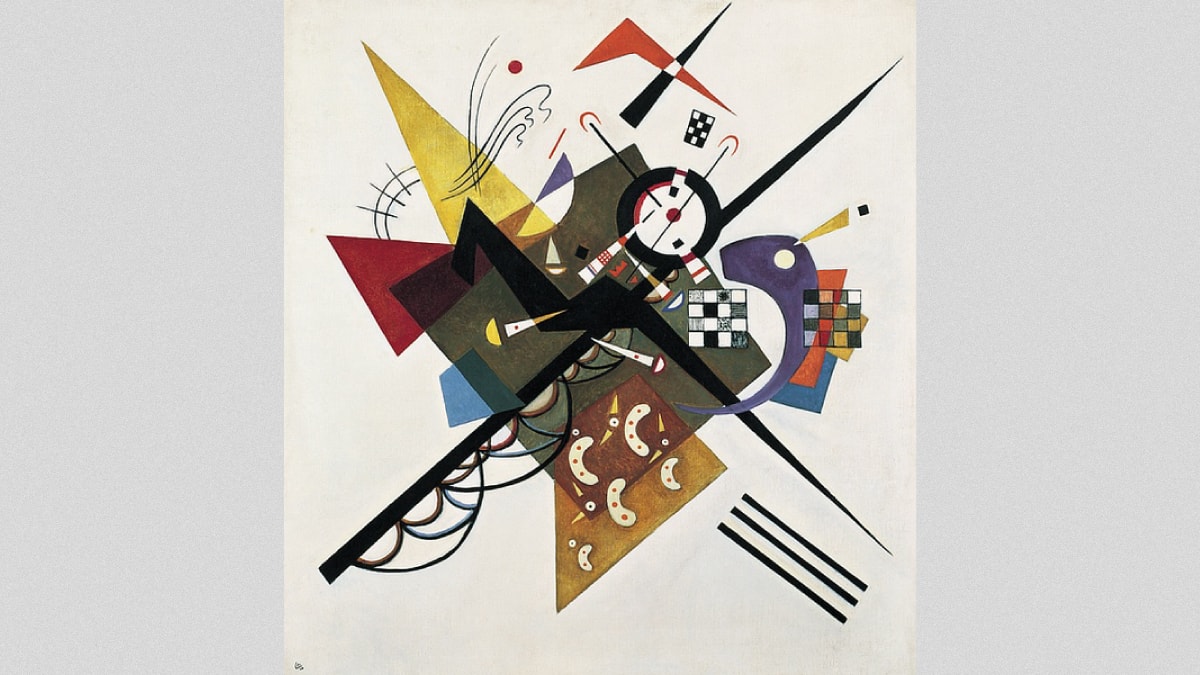
Painted in 1923, this is one of the Paintings by Kandinsky, which represents the intersection of Life and Death at every point in this physical realm.
The white color depicts the scope of opportunities in life. Other colors such as yellow, blue, red and green portray different opportunities and favorable outcomes of life.
The black cutting through the plane portrays the uncertain interruptions caused by death at any random moment in life.
Kandinsky always wanted people to break free from materialistic mindset and move towards a higher level of thoughtfulness. He truly embedded most of his expertise about expressionism in his paintings such as On White II.
15. Circles In A Circle
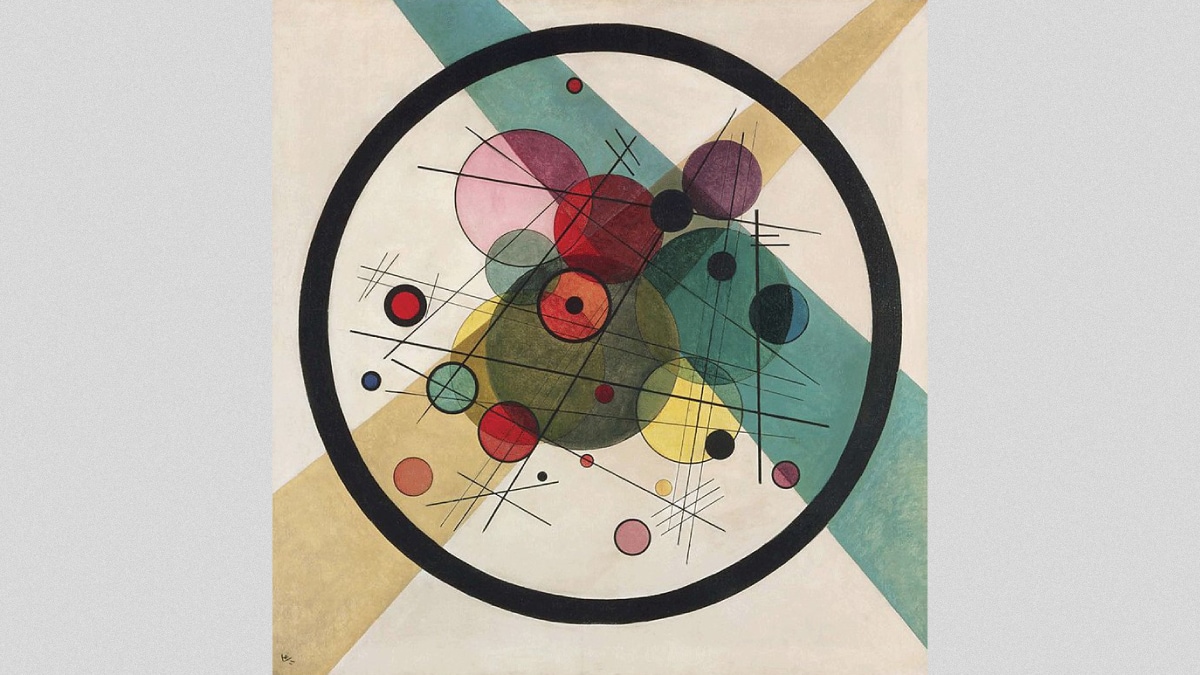
Probably the best Geometrical abstract art from Wassily Kandinsky, Circles in a Circle is not just a painting but a result of Kandinsky’s study of circles as symbols of expression art.
The peripheral circle with black boundary represents the largely bound human mind and the inner circles depict different aspects of human thought process.
The large circle encourages us to focus on interaction between the inner circles and how they complement each other.
The diagonal lines portray commonly decussating denials and approvals of our subconscious.
The two color stripes intersecting each other add a premier highlight to this Motif.
Wassily Kandinsky’s Circles used geometry to explain abstract expressions in a genius way.
Epilogue:
Wassily Kandinsky, one of the greatest painters, art theorists and philosophers to ever exist revolutionized the world of art with his peculiar perspectives.
His symphony of colors (When a person can hear colors) led to new awakenings in the world of expressionism and abstract art.
He not only questioned materialistic depiction of art but also introduced non-material and liberated perspectives to the people.
His journey and the masterpieces he created along the way, will be remembered as memoirs of transition and revolution in the world of art.
Authors Note:
I thank you all for staying till the end!
I hope you find this piece informative and interesting. I have given my best to present Kandisky’s artistic ideologies in this blog.
However if there’s anything you would like to add, the comment section is yours.
We keep on producing such interesting and trivial content for art lovers. Stay tuned with us on YouTube and Instagram for updates.
It’s such a surreal feeling having a famous artwork in your home. Wondering about how it can be done without spending millions of dollars?
At PortraitFlip, we produce highly realistic reproduction paintings with utmost accuracy and finish. Now, get your own Da vinci!
Adios! Mucho Gusto!
FAQs
Wassily Kandinsky was associated with Expressionism. He is known as one of the flag bearers of expressionism.
Composition 8 is Kandinsky’s most famous painting. It depicts Kandinsky’s expertise in depicting abstract art scenes.
Kandinsky studied Law and Economics in college. He was offered a professorship as well, but he left that offer in order to explore his passion for art.
Kandinsky studied about art at the Art School of Anton Azbe in Munich Germany.

